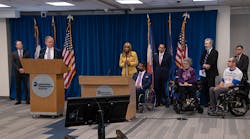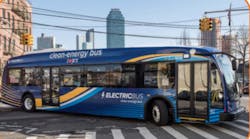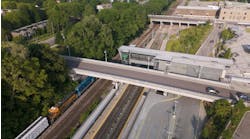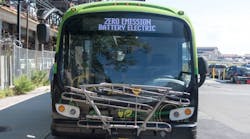MTA to install 29 new elevators at subway stations
The Metropolitan Transportation Authority (MTA) will be installing 29 new elevators at subway stations across five boroughs as part of the agency strengthening its commitment to make the New York City Subway 95 percent accessible.
The 2020-2024 Capital Program is the most ambitious accessibility program in MTA history, with $5.2 billion to make 67 stations accessible—more than the previous three Capital Programs combined.
In 2022, contracts were awarded for 13 new stations, including eight stations as part of the agency’s first Public-Private Partnership package. As a result, the MTA is currently in construction at 34 stations throughout the system.
The full list of stations being upgraded can be viewed here.
“We are determined to make the New York City Transit system fully accessible, not just for persons with disabilities, but also for seniors, for parents with children who are in strollers and travelers with luggage,” said MTA Chair and CEO Janno Lieber. “That’s why we are doing station accessibility projects at four times the pace of previous MTA Capital Programs, and why we made an agreement with disability advocates that we won’t slow down until the system is truly accessible to everyone, once and for all.”
“We are upgrading accessibility throughout the system at an unprecedented pace,” said MTA Construction and Development (C&D) President Jamie Torres-Springer. “Our 2023 commitment targets are just the latest example of MTA C&D using tools like design-build and bundling to advance these critical projects better, faster and cheaper.”
“More elevators and ramps spread throughout the subway system creates a mass transit system that is open to everyone,” said MTA Chief Accessibility Officer Quemuel Arroyo. “A large number of riders with disabilities, customers with children in strollers and visitors with luggage will benefit by being able to get to work, school and entertainment easily.”
Accessibility Task Forces
The MTA continues its long-standing commitment to accessibility across all parts of the system by utilizing Accessibility Task Forces that provide a forum for the exchange of information about services as they relate to persons with disabilities and their transportation needs.
The Task Forces also assist the MTA in identifying opportunities for enhancing accessibility & soliciting feedback on upcoming capital projects and policy issues.
Task Force members include:
- Representatives from each county within the Long Island Rail Road (LIRR) service areas
- Service partners and stakeholders, such as the New York City Mayor’s Office for People with Disabilities, Connecticut Office of Rail, and New Jersey Transit
- MTA and LIRR Staff, Board and Committee members and advocates, Permanent Citizen Advisory Council, and the LIRR Commuter Councils





